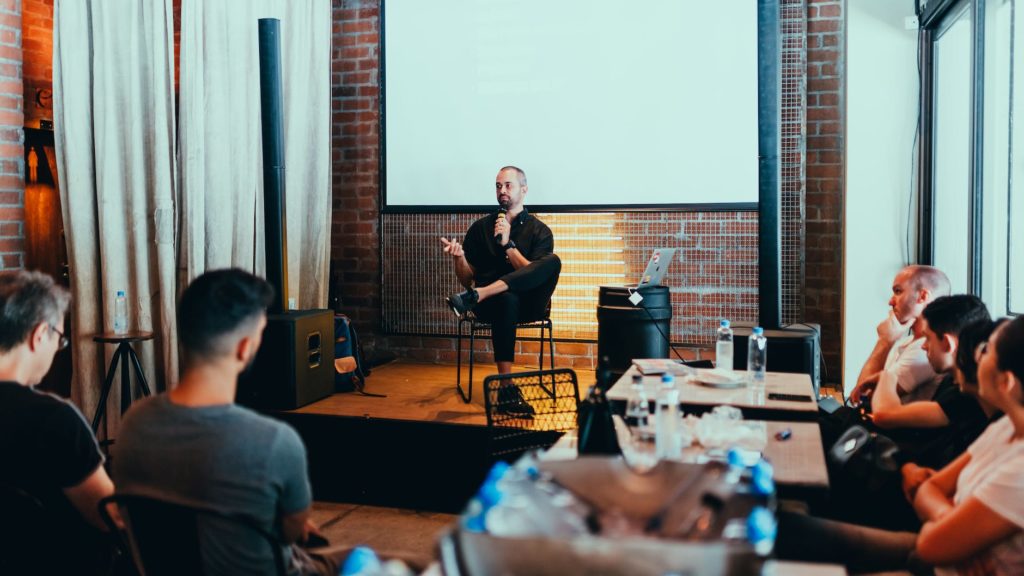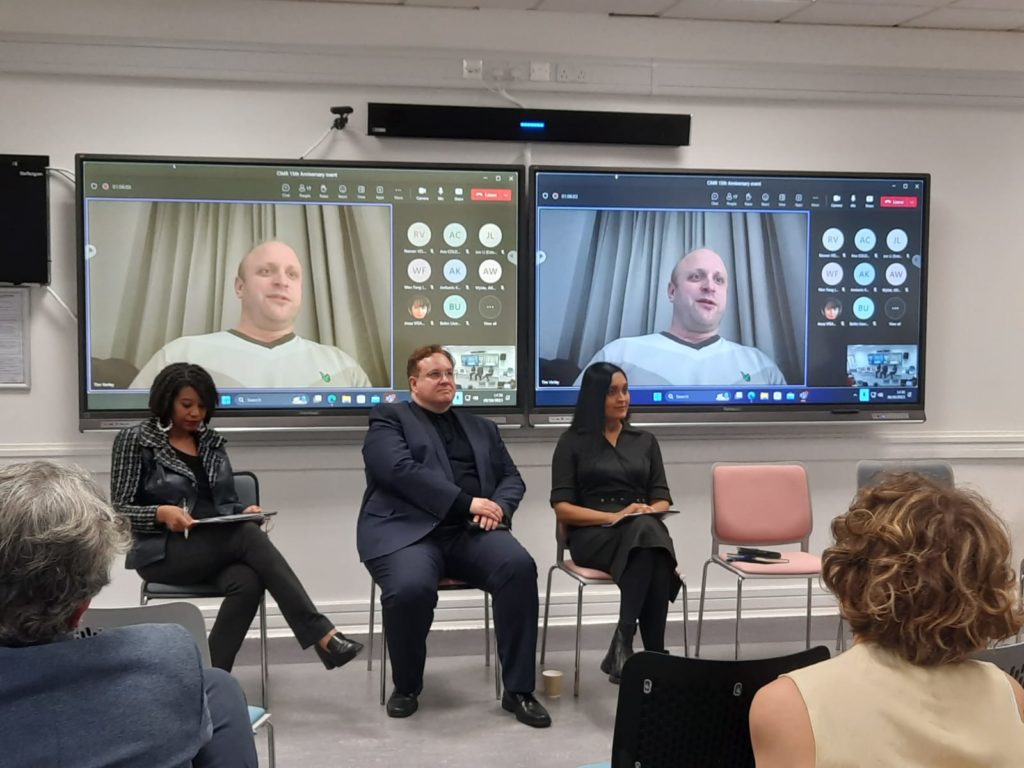On October 20th, our CIMR community celebrated its 15th Anniversary with an hybrid event and two workshops, with the first discussing the ‘Future of Innovation and Entrepreneurship Studies’. This session was chaired by Dr. Brett Anitra Gilbert and our distinguished panel of speakers included Professor Martin Meyer, University of Vaasa; Prof Tim Vorley, Oxford Brookes Business School; and Professor Muthu De Silva, Birkbeck, University of London.
The workshop covered four key areas:
- Reflecting on the developments and contributions of the entrepreneurship and innovation studies
- Future trends and under-researched areas within the field
- Making collaborations with policymakers seminal for the innovation and entrepreneurship field
- Bringing Innovation onto teaching
The full recording of the workshop is available here.
1. Reflecting on the developments and contributions of the entrepreneurship and innovation studies
The panel kicked off with an intriguing question to the panelist about their most exciting development in entrepreneurship and innovation studies in the last 15 years, and their most remarkable contribution.
Martin – Celebrating the increased influence of entrepreneurship and innovation studies and shift towards sustainability
Martin began by emphasizing that the field has come a long way in the last few decades, evolving from a niche area to becoming established as a discipline and fully integrated into the business school curriculum. Martin also celebrated the role that CIMR has played in advancing our field, with the most significant contribution being the early exploration of concepts like ecosystems and social capital in the context of innovation. Furthermore, Martin acknowledged the shift toward sustainability in this research field, which was not a common topic of discussion 15-20 years ago but has now become a focal point. He credited the field with pushing forward the alignment of research with sustainable development goals, emphasizing the modest contributions made in this direction.
Muthu’s Perspective on the Changing Landscape
Muthu expanded on Martin’s points, focusing on the changing landscape of entrepreneurship and innovation studies. She highlighted the increasing importance of working together to achieve common goals and discussed the evolution of entrepreneurship from startups to corporate entrepreneurship, academic entrepreneurship, and even public entrepreneurship. Muthu emphasized the need for different types of entrepreneurs to collaborate to achieve shared objectives. One specific area of his contribution is co-creation, a concept that seeks to harness the strengths of various entrepreneurial types to achieve common goals.
Tim’s Perspective on Engaged Scholarship
Tim highlighted the shift towards engaged scholarship in the entrepreneurship and innovation space. He pointed out that many scholars are no longer content to sit behind desks and analyze data; they are actively engaging with policymakers and intermediaries. This shift has seen research move from being on organizations and governments to research with them, emphasizing the importance of co-creation. Tim stressed that the interdisciplinarity of the field is a significant strength as it allows business schools to convene different disciplines and facilitate dialogue, which is crucial in the ever-evolving landscape of innovation and entrepreneurship studies.
2. Future trends and under-researched areas within entrepreneurship and innovation studies

The workshop continued to explore with the panelists the most promising and exciting trends in the field of entrepreneurship and innovation studies as well as which areas can be investigated further.
Muthu: The research gap related to Context, Actors, and Theoretical Concepts
Muthu highlighted research gaps in three dimensions: context, actors, and theoretical concepts.
In terms of the context, Muthu argues that the application of the co-creation principles should differ based on the context, such as sustainability and digitalization. When it comes to actors, Muthu points out a gap in understanding the roles of non-traditional actors as opposed to traditional ones. Finally, Muthu discusses the importance of applying existing theoretical concepts, such as dynamic capabilities, intellectual property, and paradox theories, in the co creation domain. She emphasizes that different actors may require different dynamic capabilities, and these capabilities can evolve over the Co creation lifecycle.
Martin: The Evolution of Research Methods
Martin echoed Muthu’s sentiment, emphasizing the rapid evolution of research methods in the last 15 to 20 years. He highlighted the transition from traditional research methodologies to modern, data-driven techniques. Open-source data and advanced analytical tools have enabled researchers to analyze large-scale datasets, providing new opportunities for insights. The advent of AI and machine learning has further accelerated the research process, although Martin acknowledged that researchers must remain vigilant about the interpretation of the data and findings. He suggested that researchers have a responsibility to educate the public on the advantages and challenges posed by the availability of research tools.
Tim: The Promise of Data-Intensive Research
Tim expanded on the role of data in the field. He highlighted the emergence of AI and ML machine learning as valuable tools for identifying emerging paradigms in various fields. He expressed excitement about the possibilities of data-intensive research to track investment trends and emerging industrial fields.
Tim also stressed the importance of social scientists providing evidence-based insights for policymakers and decision-makers. He emphasized that research isn’t just about data but also about interpreting the data and building understanding within the communities involved. Tim’s work with institutions like Innovate UK, ESRC, and UKRI illustrates the value of social science expertise in shaping effective policies and interventions.
3. Making collaborations with policymakers seminal for the innovation and entrepreneurship field

The session continued with a question to the speakers to which extent collaborations with policymakers and practitioners really are seminal in the field that you work in.
The Role of Civic Engagement in Innovation – Tim Vorley’s Perspective
Tim kicked off the discussion by shedding light on the historical and evolving role of civic engagement in innovation studies. He emphasized that the concept of universities contributing to the civic agenda has been around for centuries, but the value of these collaborations has only recently been fully appreciated.
According to Tim, the key to making these collaborations seminal lies in the way they are conducted. He stressed the importance of redefining the terms of engagement, focusing on the outcomes, and understanding how insights gained from these interactions are applied. Tim views this evolution as an exciting and necessary step, fostering openness and a willingness to learn from different perspectives. The mutual exchange of value between academia and the policy realm is the cornerstone of these collaborative efforts, creating a virtuous circle of innovation.
Nordic Governments and Openness to Experimentation – Insights from Martin
Martin shared his experiences collaborating with Nordic governments, emphasizing the openness of these nations to experimentation over the past two to three decades. They were quick to adopt concepts such as the Triple Helix framework, which focuses on the interaction between universities, industry, and government. Martin highlighted that government actors in the innovation policy arena are actively pushing the envelope and driving progress.
Funding agencies now demand a strong framework for policy learning and engagement in research proposals, reflecting a recent shift in the field. This means researchers need to be more responsive and receptive to ideas originating from the policy arena and society. As a result, a more interactive and well-integrated process has emerged, where researchers play a vital role in shaping policy and driving innovation.
Co-Creation and Co-Ownership – Muthu’s Perspective
Muthu delved into practical examples, illustrating how the relationship between researchers, policymakers, and practitioners has evolved. She outlined three key examples that signify a transition from traditional research and recommendation models to more collaborative and co-creative approaches:
1. Traditional Research and Recommendation: Historically, researchers conducted their studies and formulated recommendations for policymakers and practitioners based on their findings.
2. Collaborative Role: Muthu shared a current project where researchers and stakeholders, including UKRI, ESRC Innovate UK, and social scientists, collaborated from the project’s inception. Stakeholders actively contributed ideas and recommendations during a workshop, which significantly enriched the project.
3. Co-Creation and Co-Ownership: Muthu highlighted a recent shift where policymakers/UKRI not just offer research funding but actively participate in the research process. This approach creates shared ownership and, consequently, more relevant and impactful results.
Finally, Muthu stressed the importance of simaltaneously generate theoretically rigorous and practically impactful research. Together with publishing in top quality traditional journal she highlighted the significance of engaging and producing output in accessible formats, such as workshops and concise reports with key recommendations. This shift not only benefits policymakers and practitioners but also positions researchers as intermediaries who facilitate knowledge exchange between stakeholders.
4. Bringing Innovation onto teaching

The workshop ended with a question to the panellist on how they incorporate their innovative work into their teaching.
Tim: Fostering Experiential Learning
Tim, currently leading Oxford Brookes Business School, kicked off the discussion by emphasizing the importance of bridging the gap between academic research and practical application. One key element he mentioned is experiential learning: they invite innovators, entrepreneurs, and policymakers into the classroom, providing students with real-time challenges to tackle. They’ve also invested in facilities that allow students to experiment with technologies like machine learning and AI, preparing them for the demands of the job market. Tim’s emphasis on technology and hands-on learning aligns with the rapidly changing landscape of innovation and entrepreneurship. The aim is to equip students with skills and knowledge that are relevant to the future.
Muthu: Collaborative Learning and Real-World Problem Solving
Muthu further enriched the discussion by highlighting the transformative changes in teaching techniques. She shared that her institution has received recognition for its innovative teaching methods, including bringing entrepreneurs, innovators, and policymakers into the classroom. An inspiring example Muthu provided is how entrepreneurs present real-world challenges to students. The students then collaborate to devise solutions, often surprising the entrepreneurs themselves with solutions generated and students with their creativity and problem-solving skills. This approach not only enhances students’ confidence but also empowers them to recognize their own potential.
Muthu also stressed the importance of keeping the content relevant and up-to-date, aligning education with industry and policymaking needs. This ensures that graduates are well-equipped to enter the workforce with practical skills and knowledge.
Martin: A Mission of Sustainable Innovation
Martin encouraged universities and academic leaders to embrace innovation as a mission. He discussed the significance of giving students a meaningful challenge and making innovation the core of a university’s purpose. In his experience, sustainable innovation became the hallmark of his business school.
He emphasized that students seek challenges and the opportunity to engage in real-world problem-solving. By creating opportunities for students to take action and effect change, universities can inspire them to become change-makers in their respective fields. Martin even shared a practical example where students were taken out of the classroom for a week to address a local sustainability issue.
Conclusions

The CIMR workshop on the future of innovation and entrepreneurship studies provided valuable insights a platform for thought leaders to discuss the evolving trends and challenges in this field.
The discussions highlighted the evolution of entrepreneurship, the increasing emphasis on sustainability, and the need for collaboration among different types of entrepreneurs. The insights shared by the panelists underscored the importance of context in co-creation, and the growing potential of data-intensive research. As the field continues to evolve, interdisciplinary collaboration, ethical considerations, and a focus on delivering actionable insights will remain crucial to advancing innovation and entrepreneurship studies.
With the rapid pace of change and the continual development of research methods, the future of this field promises exciting possibilities. Researchers and practitioners should remain adaptable, embrace emerging technologies, and work together to unlock the full potential of innovation and entrepreneurship, including the incorporation of innovative teaching approaches to ensure that their students are well-prepared for the ever-changing landscape of innovation and entrepreneurship.
We would like to thank again our panel members for their invaluable contributions on this session.

